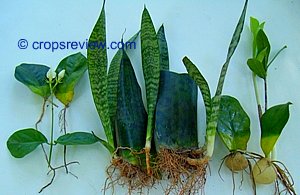Plant cuttings are segmented parts of plant organs that are used in vegetative propagation.
Just like other asexual or vegetative propagation methods, the use of cuttings allows the production of clones or plants which are considered “duplicates” of the parent plants genotypically.
It is advantageous where a plant does not produce seeds, the seeds are sterile, or whenever seeds are not available.
With crops that can be easily propagated using cuttings, this method has numerous advantages.
Many new plants can be produced in a limited space from a few stock plants.
It is simple and can be easily applied without having to learn the special techniques in grafting or budding.
It is rapid because there is no need to produce rootstocks.
Plant cuttings may consist of segments of the root or whole leaves or portions of leaves, or segments of stems that are used as starter planting materials.
Depending on the plant part used, these propagules are called by special terms such as root cuttings, leaf cuttings, leaf-bud cuttings, or stem cuttings.
In sugarcane, the stem cutting is called cane cutting while in bamboo, it is culm cutting.
Culm is the technical term for the main stem of plants belonging to the grass family Gramineae (alternatively named Poaceae ).

Root cuttings are segments of the root while leaf cuttings are either entire leaves, with or without the petiole, or portions of leaf blades.
Leaf-bud cuttings consist of a leaf with a petiole and a short piece of the stem with an axillary bud.
Stem cuttings are segmented parts of the stem or entire stems detached from the main branch.
Where the stem cutting includes the tip or apex, it is called tip cutting.
Special terms are also used to classify stem cuttings such as hardwood or woody cuttings, semi-hardwood or semi-woody cuttings, softwood cuttings, and herbaceous cuttings.
These are classifications of stem cuttings based on the nature of wood and stage of growth.
Hardwood, semi-hardwood, and softwood cuttings are taken from woody trees and shrubs while herbaceous cuttings are made from succulent, herbaceous plants like chrysanthemum, coleus, tomato, and squash.
Propagation with the use of plant cuttings is common for dicots but there are some monocots that can be rooted by this method like bamboo and sugarcane.
Compared to the other methods, propagation by stem cuttings has the widest application.
Plant Cuttings as Propagation Materials
Examples of Plants That Can be Propagated by Root Cuttings:
Breadfruit (Artocarrpus altilis), blackberry (Rubus sp.), fig (Ficus carica), garden phlox (Phlox paniculata), Japanese pagoda tree (Sophora japonica), lilac (Syringa vulgaris), Malus sp., oriental pear (Pyrus calleryana), Rosa spp.
Examples of Plants That Can be Propagated by Leaf Cuttings Either Intact or Segmented or Both:
African violet (Saintpaulia ionantha), Begonia spp, Bryophyllum spp, jade plant (Crassula spp.), Kataka-taka (Kalanchoe spp.), Lily (Lilium spp.), Oxalis spp., Peperomia spp., Sedum spp., snake plant (Sansevieria spp.), wax plant (Hoya carnosa). Generally, these plants have thick leaves.
Jasmine or sampaguita (Jasminum sambac) and spotted dracaena (Dracaena godseffiana) have also been propagated experimentally by leaf cuttings.
Examples of Plants That Can be Propagated by Aerial Stem Cuttings
Stem cutting propagation is most common in ornamental plants.
The technique, however, also applies to other species which are commonly propagated by seeds.
Some of these are found among the examples given below:
Acerola (Malpighia glabra), avocado (Persea americana), bamboo (many species), black pepper (Piper nigrum), bottle gourd (Lagenaria siceraria) cacao (Theobroma cacao), coffee (Coffea spp.), cassava (Manihot esculenta), citrus (Citrus spp.), coffee (Coffea spp.), eggplant (Solanum melongena), grape (Vitis vinifera), guava (Psidium guajava), ilang-ilang (Cananga odorata), kakawate or madre de cacao (Glericidia sepium), lagundi (Vitex negundo), lanzones (Lansium domesticum), molave (Vitex parviflora), narra (Pterocarpus indicus), Norfolk Island Pine (Araucaria heterophylla), passion fruit (Passiflora spp.), pili nut (Canarium ovatum), pineapple (Ananas comosus), rubber (Hevea brasiliensis), red mombin (Spondias purpurea), sambong (Blumea balsamifera), sampagita or jasmine (Jasminum sambac), santol (Sandoricum koetjapi), sapodilla (Manilkara zapote), starapple (Chrysophyllum cainito), squash (Cucurbita maxima), tsaang gubat or wild tea (Ehretia microphylla), tomato (Lycopersicon esculentum), tubli (Derris sp.).
Note: Plant cuttings may not always produce the desired plant characteristics.
The use of plant cuttings in propagating variegated plants may result in reversion to the normal, evergreen type.
This occurs when the variegated snake plant (Sansevieria sp.) is propagated by leaf cutting.
This is because these plants are periclinal chimeras in which the inner cross-sectional areas of the plant body are normal while the thin outer layers are mutated cells that are responsible for the variegation.
With root and leaf cuttings, the new plant regenerates from the inner normal cells, resulting in normal growth and loss of variegation.
In snake plants, the variegated character can be perpetuated by the division of rootstock instead of leaf-cutting propagation.
REFERENCES
ABELLANOSA AL, PAVA HM. 1987. An Introduction to Crop Science. CMU, Musuan, Bukidnon: Publications Office. p. 71-87.
HARTMANN HT, KESTER, DE. 1975. Plant Propagation: Principles and Practices. New Jersey: Prentice-Hall, Inc. p. 211-313.
